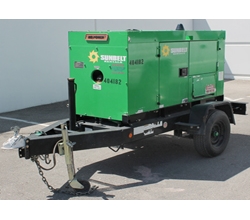
The Code
To eliminate any problems or issues when operating a generator we should all be familiar with the laws and codes concerning power systems, as well as the safe operation and safety aspects of using portable power systems.
The place to start is the National Electrical Code (NEC), sponsored by the National Fire Protection Association (NFPA) and published every three years. The current edition is from 2011, with the next revision due in 2014.
The purpose of the NEC is to safeguard people and property from electrical hazards caused by improper electrical wiring or unsafe practices. The actual code issued by NFPA is not a law, but rather an advisory document that outlines best/safe practices and offers warnings of known dangers.
Local municipalities can (and many do) legislate and adopt the current version of the NEC as law. Some may adopt the code it in its entirety, while others adopt parts of it and make changes (usually more stringent ones) to certain sections. Therefore, it’s important to check with a local government’s electrical inspectors and ascertain their specific code requirements.
Code sections of interest to production companies include articles 520, 525, 590, 640. Article 520 applies to structures used for presentations and performances including theaters, assembly halls and stages. Article 525 addresses the installation of portable wiring and equipment for carnivals, circuses, fairs, and similar functions. Article 590 focuses on the installation of temporary power and lighting, and Article 640 covers portable and/or temporary audio system installations.
Word To The Wise
There are several things to keep in mind when working with a generator. Park the unit on a flat level site with easy access for refueling. It should not be located in an area accessible by the general public.
Chock the wheels on a parked generator to prevent unwanted rolling. Always install a ground rod or tie the unit into an existing approved ground as per the local code.
In addition, check oil, fuel and water levels before use and monitor these levels throughout the day. Check and set all voltage and phase switches to the proper settings for your needs. Place all load breakers in the “off” position before starting or stopping the unit. Make sure the generator is not running when connecting cables to the lugs.
Always connect the ground wire first, then the neutral, then the hot legs. Meter the outputs before connecting your equipment to ensure the unit is operating properly.
If you’re towing a generator, make sure the vehicle is able to handle to weight of the tow. Check the tow hitch and coupling for any signs of wear or damage. Make sure that the tow vehicle’s lights and brakes are in good condition.
Finally, check the tire pressure on both vehicle and trailer, and especially check tires frequently on multi-axle trailers because a flat may go unnoticed while being towed. Always use the safety chains when towing. The chains should be long enough for tight turns and be crossed (left to right, right to left) under the hitch creating a basket that can catch the trailer in case of a failure.
Craig Leerman is senior contributing editor for Live Sound International and ProSoundWeb.
